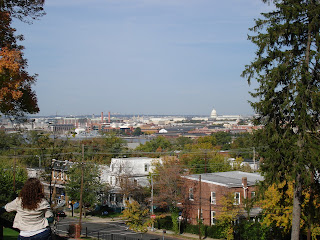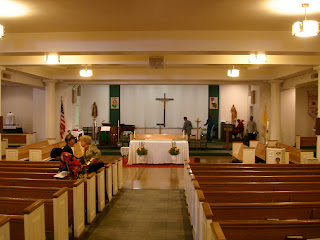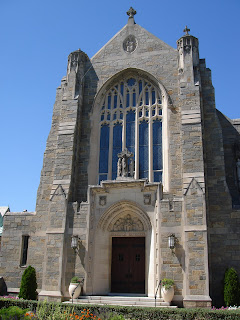It’s been a while since I’ve gone church-exploring, so this week I got right back on the horse. I brought two new friends to church this week, John and Kate (Plus Michael! Get it?). John is a missionary with the Fellowship Of Catholic University Students (FOCUS) and is busy spreading the Word at GW. Kate is a student at Gallaudet University, a college for deaf students, (she can hear, but she’s studying deaf education) who hangs out a lot at the GW Newman Center. I decided to bring them to St. Teresa of Avila in Anacostia, in the Southeast part of Washington, D.C.
One of the reasons I wanted to go to “STA” was that it was close to a little-known D.C. landmark called the “Big Chair.” It is, as its name suggests, a 19-foot tall chair, created by a furniture company in 1959 and cherished ever since by local residents, it even made an appearance in a recent Wale music video (
here, around 1:49). It was very cool, but not nearly as cool as the Mass we were about to attend.
The church had a pretty simple design, a pentagonal façade with few architectural flourishes. The walls of the inside of the church were bare white for the most part. As I walked in, the first I thing I noticed was the large painting of Jesus on the wall behind the altar. He appears to be seated on a throne in the middle of space, with stars, the Earth and the moon in the background. On second glance, Jesus is actually engulfed in yellow light, and is thus shown as being separate from Earth, space, and the moon. Quite frankly though, it was still the strangest-looking piece of art I’ve ever seen inside a church. Also behind the altar was a red, bush-looking statue that John guessed was a representation of the burning bush.
As we walked in, the church was about half-full, and some of the parishioners were praying the rosary together. Things quickly livened up, however, as the young adult choir started belting out the opening hymn. The choir got everyone moving (see video below) and I soon found myself clapping my hands and moving from side to side. They were led by a fantastic piano player, who also served as the choir director. My favorite choir moment was when they stood on the church’s balcony (in the rear of the church, where many churches have their organ players) and performed a brilliant a cappella rendition of the Negro spiritual “I Opened My Mouth To The Lord,” with the choir director furiously directing them from the front of the church.
The Mass was similar to many of those I’ve seen at other D.C. Black Catholic parishes, but STA had its own unique sense of emotion and enthusiasm. These folks all seemed to be very much part of a community, with their own traditions and shared memories. John liked that the readers of the Word would make sure to announce which specific books, chapters, and lines they’d be reading from, and the parishioners would all pull out their Bibles and follow along.
John, Kate, and I had a very warm welcome into the STA community. Just like in many other black parishes, all visitors were asked to stand up and introduce themselves. Once the three of us did this, we sat down, but the people sitting near us told us to remain standing. After standing for a minute as the other visitors introduced themselves, I asked the man in front of me why we were supposed to stay standing. He then stood up, and said, “We’ve got a gift for y’all,” as he opened his arms to give me a hug. The rest of the parish stood up, and the hugs didn’t stop for about five minutes. It was a tremendous way of welcoming folks into the church. Kate was a hit with the whole parish because of something that she did later in the Mass. When the pastor, Monsignor East, heard that she was from Gallaudet, he asked her to pray the “Our Father” in American Sign Language for the rest of the parish. He told the parish to follow along, and it was great fun watching people try to copy Kate’s signs.
Monsignor East, the pastor, was a fantastic man. He came into the church smiling and didn’t let up for the whole Mass. When the choir began to sing the “Hallelujah,” before the Gospel reading, he stopped them mid-song, and reminded everyone that “Hallelujah” means “Praise the Lord,” and encouraged everyone to sing louder! His sermon was very colorful, and he used a mix of humor and seriousness to speak to his audience. In the day’s Gospel readings, Jesus contrasts a Pharisee who brags of his holiness in his prayers to God, and a tax collector who merely asks forgiveness for his sins. To illustrate this, he brought Tasha, a choir member to the back of the church with him. He pretended to act out the part of the Pharisee, talking about how he was holy and righteous and Tasha said, referring to herself, “unlike this heathen!” In his sermon, he talked about the struggle many people have in coming back to church and asking God’s forgiveness for their sins. He talked about people who had left the church, and cited Tasha as an example of someone who had come back after falling away from the church. He referenced Tasha multiple times, and the sermon became very emotional for her. He eventually brought her back up, and she received hugs from several members of the parish. In this way, Monsignor East demonstrated the deep connection he had with his parishioners and the meaningful effect that his work has had on their lives. Sunday was his 60th birthday, and the three of us were happy to sign birthday cards for him.
After a tremendously moving Mass, we finished the trip off with a quick visit to the Frederick Douglass National Historical Site, just a few blocks away from STA. It was Douglass’s former home, and although we didn’t get to go inside, we got to see his terrific view of Washington, D.C. Just another reason to love this city and this project.
Links:
Pictures
The Big Chair
St. Teresa of Avila Roman Catholic Church
Video of the Choir Singing the Closing Hymn
Frederick Douglass National Historical Site
















































